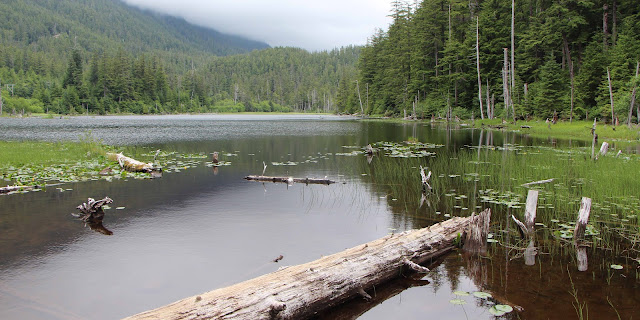 |
| Sitka looks good in the rain (my hair doesn't) |
Well, we then took off for our last Alaska destination. It's hard to believe that our trip is ending. Because Juneau was misty and we'd seen everything, we got up early and went to the ferry dock to see if we could change our reservations to Sitka to a day early.
 |
| Typical Alaska |
 |
| He was glad he brought his guitar |
 |
| Our boat |
We were on the M/V Fairweather. It is one of the fast ferries and the journey was spectacular.
We went north from Juneau (retracing some of the trip we had taken to Gustavus) and even passed an active Whale watch (lazy Humpback Whales again).
 |
| The scenery was pretty going both ways |
 |
| Just scraping by |
 |
| Thank you! |
Sitka
Sitka is is situated on the west side of Baranof Island and the south half of Chichagof Island in the Alexander Archipelago of the Pacific. Bigger than many places we visited, the population is about 8,000.
Russian explorers settled Old Sitka in 1799, naming it "Fort of Archangel Michael." In 1802, Tlingit warriors destroyed the settlement, killing many Russians, with only a few managing to escape. Russian America Governor Alexander Baranov levied 10,000 rubles in ransom for the safe return of the survivors.
Baranov returned to Sitka in 1804 and, after two days of heavy bombardment, the Tlingits surrendered. The Russians established the settlement "New Archangel," which eventually became the largest city in the region.
The Tlingit re-established their fort across Peril Strait to enforce a trade embargo with the Russians. In 1808, Sitka was designated the capital of Russian America.
Sitka served as the Capital of the Department of Alaska until 1884 and, as capital of the District of Alaska from 1884 to 1906.
 |
| Sitka is very swampy |
The seat of government was relocated north to Juneau in 1906 due to declining economic importance of Sitka relative to Juneau, which had experienced considerable population gain in the Klondike Gold Rush.
In 1937, the U.S. Navy established the first seaplane base in Alaska on Japonski Island. In 1941, construction began on Fort Ray, an army garrison to protect the Naval air station. Both the Army and Navy remained in Sitka until the end of WWII, when the Army base was put into caretaker status. The naval station in Sitka was deactivated in June 1944.
Our Visit
We found a gorgeous campsite at Starrigavan Recreation Site.
There was practically no one there and signs saying a brown bear had been seen in the vicinity.
 |
| There were lots of berries for the Bears to eat |
We never saw the bear, but enjoyed the lush, fairy tale surroundings and (relative) lack of mosquitoes.
 |
| Nice to relax at the campsite |
 |
| This also looks nice |
 |
| Damp and dripping |
Unfortunately, the weather turned the next day, so we did laundry!
We did stop at several places:
1. Downtown, where we visited St. Michael's Russian Orthodox Cathedral
 |
| As green and lush as the campsite |
... and totems ...
 |
| The best collection I have seen |
 |
| The women dance both male and female roles |
 |
| Photo: Patrick Endres |
 |
| Photo: Northwest Arkansas Democrat-Gazette |
Somehow, watching a male grizzly stand and pose for pictures and beg for food REALLY depressed me. We stayed about five minutes. Very sad. I am not sure the bears are actually rescued.
8. The Baranof Castle site, with lovely views of rainy Sitka.
8. The Baranof Castle site, with lovely views of rainy Sitka.
 |
We have a large collection of Alaskan art; this is not from Sitka |













No comments:
Post a Comment